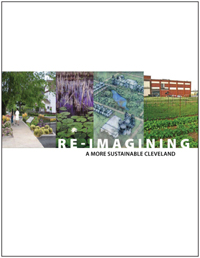
Re-imagining a More Sustainable Cleveland starts from the premise that the loss of population over the last 60 years is not likely to be reversed in the near term and that Cleveland’s future ability to attract and retain residents depends in large part on how the city adapts to population decline and changing land use patterns. The reuse of vacant land is crucial to Cleveland’s potential to be a “green city on a blue lake.”
There are approximately 3,300 acres of vacant land within city limits, and an estimated 15,000 vacant buildings. Many of these vacant properties are poorly maintained and they diminish the value of the remaining, more viable buildings and neighborhoods in the city. The city demolishes about 1,000 vacant houses per year; private demolitions and fires are also reducing the number of derelict structures in the city. After demolition, surplus land becomes a raw asset for the city–a resource for future development as the city’s population stabilizes and progress is made toward recovery. The Re-imagining a More Sustainable Cleveland working group was formed to explore ways to put this land to productive use.
The Re-Imagining a More Sustainable Cleveland handbook explores strategies for reuse of vacant land with the goal of making Cleveland a cleaner, healthier, more beautiful, and economically sound city. The 30-member working group was convened by Neighborhood Progress in collaboration with the City of Cleveland and Kent State University’s Cleveland Urban Design Collaborative with funding from the Surdna Foundation.
Going forward, the City of Cleveland has the opportunity to use its excess land in ways that:
- Advance a larger, comprehensive sustainability strategy for the city,
- Benefit low-income and underemployed residents,
- Enhance the quality of neighborhood life
- Create prosperity in the city
- Help address climate change.
With the support of community partners, the Surdna Foundation, and other funders, Neighborhood Progress, Inc. is committed to implementing pilot projects over the next several years and assisting the city and other partners in determining how to bring the most successful initiatives to fruition.
If you have an idea for re-utilizing a vacant lot in the Cleveland Land Bank (vacant land owned by the city), please attend one of Re-Imagining a More Sustainable Cleveland’s public workshops to get the materials and resources you need to start implementing your idea. If your application is accepted, you can get a grant (read $$$) to build a community garden, an urban farm, a phytoremediation project (meaning you use plants to take toxins out of the soil), or any other use you can think of in a vacant lot for the next 5 years (5 years are guaranteed, but after that, the city may actually give you the land).
Here are the kinds of projects that will be accepted:
- Productive use / public benefit: Whether vacant properties are developed with buildings and infrastructure, preserved as open space, or put into productive use as agriculture or energy generation sites, they should provide an economic return, a community benefit, and/or an enhancement to natural ecosystems.
- Ecosystem function: Stormwater management, soil restoration, air quality, carbon sequestration, urban heat island effects, biodiversity, and wildlife habitat should be incorporated into future plans for vacant sites in the city.
- Remediation: Remove the risk to human health and the environment from environmental pollutants at vacant sites, either with targeted remediation projects or with long-term incremental strategies.
The “Re-Imagining” plan identifies a range of vacant land strategies including:
- Neighborhood stabilization and holding strategies
- Green infrastructure strategies to expand recreation opportunities and the green space network, improve ecosystem function and remediate contaminated properties
- Productive landscapes (i.e. agriculture and energy generation)
We need your ideas and energy to help revitalize our city! Apply for a grant to reuse a vacant lot!
The deadline for applications is July 31, 2009.

Pingback: Cleveland’s Strengths and Areas for Improvement « Renovating the Rust Belt
Pingback: Structural Racism and Sustainable Solutions in Detroit « Renovating the Rust Belt